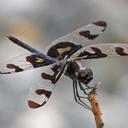United States and Canada
This species is easily identified by its dark color and clear wings with large black spots. Its face and body are bright yellow, but quickly become black or dark blue in males. The thorax is yellow, striped with black on the humeral, midlateral and third lateral sutures, but becoming entirely black at maturity. The wings are clear with a large basal black spot extending out to the nodus and encompassing an amber area centrally in the hindwing. There is a dark sp ot in the outer half of each wing and the wingtips are black. The abdomen is black with pale yellowish dorsal markings on segments 5-7 that quickly become obscured in older individuals.
Size: Total length: 28-38 mm; abdomen: 17-26 mm; hindwing: 24-32 mm.
Similar Species (south-central US): Halloween Pennant (C. eponina) has orange wings. The basal markings in the hindwing of Calico Pennant (C. elisa) are smaller and don't extend out to the level of the nodus.
Habitat: Permanent lakes, ponds and borrow pits with emergent vegetation.
Natural History: Banded Pennant prefers protected areas of ponds and lakes with thick growths of trees or bushes. They forage, as do other species in this group, from tall grasses or stems. They often perch, in a similar fashion to Halloween Pennant, with the forewings elevated above the hindwings. Females lay eggs accompanied by males or alone.
Distribution: Eastern U.S. from New York to Texas.
Source: Abbott, J.C. 2006-2010. OdonataCentral: An online resource for the distribution and identification of Odonata. Available at OdonataCentral.
Edited by Drew Weber (9/24/2015).
